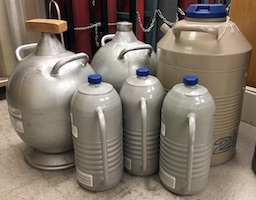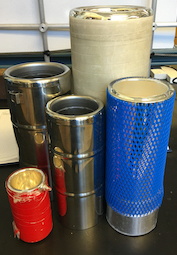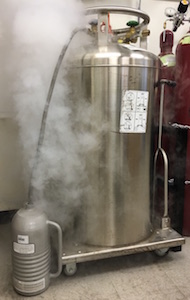Liquid Nitrogen
Introduction
This method describes everything related to liquid nitrogen. How to obtain it, how to safely transfer from vessel to vessel, and what to do with empty large dewars.
Safety
Risks associate with liquid nitrogen are related to very cold temperature, asphyxiation, and potential high pressure. You are expected to have read and understood the SDS for liquid nitrogen. EH&S has an online course called Liquid Nitrogen Safety that you must complete.
Liquid nitrogen is -196 °C. It can cause frost bite (cryogenic burns) very quickly. NOTE, however, that a splash onto the skin is very unlikely to be a medical emergency, as suggested by the EH&S video, thanks to the Leidenfrost effect. Your skin is very hot relative to liquid nitrogen, and upon contact, an insulating layer of air forms between your skin and the liquid nitrogen. You still need to be careful; liquid nitrogen is very cold and it can cause frost bite. Wear protective clothing (close-toed shoes, pants, gloves, and safety glasses) when transferring liquid nitrogen from vessel to vessel.
Liquid nitrogen evaporates very quickly and can remove oxygen from the local area, making it a potential cause of asphyxiation. IsoLab has very high air turnover rates thanks to the many fume hoods, fume snorkels, and general high HVAC flow rates. Still, if you happen to be working with liquid nitrogen and power goes out or the air circulation is faulty, prop open the lab doors to the hallway.
If liquid nitrogen is enclosed in an air tight container, a high pressure may result in explosion. No container meant to hold liquid nitrogen is air tight. The dewar caps shown below are all loose fitting for this purpose.
Liquid nitrogen container types





Large Floor Dewars
The large, 180 L or 230 L, dewars are delivered by Airgas to the hallway outside rooms 302 / 303 on Monday and Thursday mornings. If you have ordered a second dewar after Monday morning, it will most likely arrive Thursday morning.
The large, 180 L or 230 L, dewars have three valves on top. One for using liquid nitrogen, one for using nitrogen gas, and a third one that allows users to pressurize the headspace in the event it doesn't have head pressure. We need a head pressure for the liquid nitrogen to come out. Some dewards are set to have a 22 psi head pressure while others are set to have a 35 psi head pressure.
Handheld Dewars
The hand-held dewars are used to transfer liquid nitrogen from the large, floor dewars to your place of work. The larger of the hand-held dewars can be used as your daily allotment and the smaller hand-held dewars can be used to fill the open-top dewars. You can use a funnel to transfer between hand-held dewars.
Open-top Dewars
Open-top dewars come in a wide range of sizes. They are made of stainless steel or glass. Be careful with the glass varieties. Since all dewars have an evacuated space between the outside and inside walls, the glass dewars will make a loud pop if dropped and glass will travel far.
When you are finished with the liquid nitrogen in an open-top dewar, use a funnel to dump the remaining liquid back into a hand-held dewar.
Filling from Large, Floor Dewars
Use the liquid nitrogen station area to fill hand-held dewars from the large, floor dewar. You will find safety goggles, gloves, cryo-hose, and a wrench here. Attach the hose to the liquid port if it is not already. Put the other end of the hose into the hand-held dewar you wish to fill. Don goggles and gloves. Hold the hose with one hand to keep it steady and then open the valve with your other hand. The liquid nitrogen will boil immediately upon hitting the warm hose and it will sputter and puff and whistle. This will calm down after the hose cools. Continue filling until full or until the desired amount is dispensed. If the large dewar begins to whistle and does not stop whistling, the large dewar is empty. Turn off the valve, remove the hose, tear off the bottom part of the tag, and roll the dewar into the hallway.
Filling Among Handheld Dewars
To fill among the various hand-held dewars, use one of the funnels. Place the funnel in the dewar you wish to fill. Lift the dewar you are filling from and pour until the desired amount has been transferred. If the dewar you are filling is warm, it will take some time to first cool it down. You will know it's warm because the liquid nitrogen immediately boils when entering the dewar. You will observe lots of splashing and it will seem difficult to make any progress at all. The best way to cool a warm hand-held dewar is to use the large, floor dewar and hose. Once the hand-held is cool, pouring in as originally intended will be much easier.
Empty Dewars
Remove the hose and tear off the distal portions of the tag when large floor dewars are empty. Then, take the large floor dewars (230 L and 180 L) to the ATG loading dock. Leaving them in the hallway is a temporary solution. Before the end of the day, please take down empty dewars.
If you do empty a large floor dewar, find the QR code and order more.
